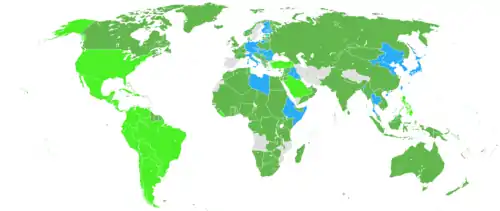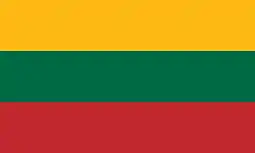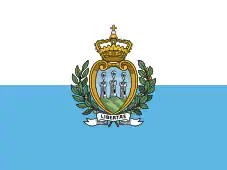Neutral powers during World War II
The neutral powers were countries that remained neutral during World War II. Some of these countries had large colonies abroad or had great economic power. Spain had just been through its civil war, which ended on 1 April 1939 (five months prior to the Invasion of Poland)—a war that involved several countries that subsequently participated in World War II.

During World War II, the neutral powers took no official side, hoping to avoid attack. However, Portugal, Sweden, and Switzerland all helped the Allies by supplying "voluntary" brigades to the United Kingdom, while Spain avoided the Allies in favor of the Axis, supplying them with its own voluntary brigade, the Blue Division. Ireland generally favoured the Allied side, as with the United States. The United States remained neutral until 8 December 1941, a day following the attack by Japan on Pearl Harbor.
The Lateran Treaty between Italy and the Vatican, signed in 1929, required that the Pope maintain "perpetual neutrality in international relations"—making the Vatican City a neutral state.
Several countries suffered invasions in spite of their efforts to be neutral. These included Nazi Germany's invasion of Denmark and Norway on 9 April 1940—then Belgium, the Netherlands, and Luxembourg on 10 May 1940. On the same day, 10 May 1940, the British, having already invaded the Faroe Islands in April, invaded Iceland and established an occupying force (subsequently replaced by the then-neutral United States). The Soviet Union invaded Lithuania on 15 June 1940 and Latvia and Estonia on 17 June. In the Balkans, the Italo-Greek War began on 28 October 1940 and Yugoslavia was invaded in April 1941. Iran was also attacked and occupied by Britain and the Soviet Union in August 1941.
See also the histories of Afghanistan, Andorra, Guatemala, Liechtenstein, Saudi Arabia and Yemen during this period.
Continent
Estonia
 Estonia – Estonia, along with its Baltic neighbours Lithuania and Latvia, jointly declared their neutrality on 18 November 1938, in Riga, at the Conference of Baltic Foreign Ministers with their respective parliaments passing neutrality laws later that year.[1] Despite that, all three Baltic states were occupied twice by the Soviet Union and once by Nazi Germany.
Estonia – Estonia, along with its Baltic neighbours Lithuania and Latvia, jointly declared their neutrality on 18 November 1938, in Riga, at the Conference of Baltic Foreign Ministers with their respective parliaments passing neutrality laws later that year.[1] Despite that, all three Baltic states were occupied twice by the Soviet Union and once by Nazi Germany.
Iceland
.svg.png.webp) Iceland – Occupied by Allied forces from May 1940.
Iceland – Occupied by Allied forces from May 1940.
Ireland
 Ireland – The policy of Irish neutrality during World War II was adopted by the Oireachtas (Irish Parliament) at the instigation of Éamon de Valera, the Taoiseach (head of government) upon the outbreak of hostilities in Europe. It was maintained throughout the conflict, in spite of several German air raids and attacks on Ireland's shipping fleet by both Allies and Axis. De Valera refrained from joining either the Allies or Axis powers
Ireland – The policy of Irish neutrality during World War II was adopted by the Oireachtas (Irish Parliament) at the instigation of Éamon de Valera, the Taoiseach (head of government) upon the outbreak of hostilities in Europe. It was maintained throughout the conflict, in spite of several German air raids and attacks on Ireland's shipping fleet by both Allies and Axis. De Valera refrained from joining either the Allies or Axis powers
Latvia
 Latvia – Latvia, along with its neighbours Lithuania and Estonia, jointly declared their neutrality on 18 November 1938, in Riga, at the Conference of Baltic Foreign Ministers with their respective parliaments passing neutrality laws later that year.[2] Despite that, all three Baltic states were occupied twice by the Soviet Union and once by Nazi Germany.
Latvia – Latvia, along with its neighbours Lithuania and Estonia, jointly declared their neutrality on 18 November 1938, in Riga, at the Conference of Baltic Foreign Ministers with their respective parliaments passing neutrality laws later that year.[2] Despite that, all three Baltic states were occupied twice by the Soviet Union and once by Nazi Germany.
Lithuania
 Lithuania – Lithuania, along with its neighbours Latvia and Estonia, jointly declared their neutrality on 18 November 1938, in Riga, at the Conference of Baltic Foreign Ministers with their respective parliaments passing neutrality laws later that year.[3] Despite that, all three Baltic states were occupied twice by the Soviet Union and once by Nazi Germany.
Lithuania – Lithuania, along with its neighbours Latvia and Estonia, jointly declared their neutrality on 18 November 1938, in Riga, at the Conference of Baltic Foreign Ministers with their respective parliaments passing neutrality laws later that year.[3] Despite that, all three Baltic states were occupied twice by the Soviet Union and once by Nazi Germany.
Portugal
 Portugal – Portugal was officially neutral during World War II. However, it maintained a close relationship with the UK, due to the alliance it had for the last six hundred years, which is the longest lasting military alliance in history. The Estado Novo sought neutrality in order to keep Spain neutral and prevent it from joining the Axis. Portugal allowed the United States to use a secret military base at Santa Maria Airport in the Azores through a military agreement signed on 28 November 1944. This violated its neutrality and rendered Portugal as a non-belligerent on the Allied side.
Portugal – Portugal was officially neutral during World War II. However, it maintained a close relationship with the UK, due to the alliance it had for the last six hundred years, which is the longest lasting military alliance in history. The Estado Novo sought neutrality in order to keep Spain neutral and prevent it from joining the Axis. Portugal allowed the United States to use a secret military base at Santa Maria Airport in the Azores through a military agreement signed on 28 November 1944. This violated its neutrality and rendered Portugal as a non-belligerent on the Allied side.
Colonies of Portugal:
 Angola
Angola Cape Verde
Cape Verde Portuguese Guinea
Portuguese Guinea Portuguese India
Portuguese India Macau
Macau Mozambique
Mozambique São Tomé and Príncipe
São Tomé and Príncipe Portuguese Timor (Occupied by Japan from 1942 to 1945)
Portuguese Timor (Occupied by Japan from 1942 to 1945)
Spain
![]() Spain Initially holding to formal neutrality, once Italy entered the war in June 1940 Francisco Franco switched Spain to the status of "non-belligerent" and proceeded to occupy Tangiers. From June 1940 onward, and until February 1941, the Francoist regime was greatly tempted to interventionism. Prominent Germanophile Ramón Serrano Suñer had great ascendancy in the government.[4] However, meetings with German officials, including the meeting between Franco and Hitler in Hendaye on 23 October 1940, did not bring formal entry of Spain into the war.
Spain Initially holding to formal neutrality, once Italy entered the war in June 1940 Francisco Franco switched Spain to the status of "non-belligerent" and proceeded to occupy Tangiers. From June 1940 onward, and until February 1941, the Francoist regime was greatly tempted to interventionism. Prominent Germanophile Ramón Serrano Suñer had great ascendancy in the government.[4] However, meetings with German officials, including the meeting between Franco and Hitler in Hendaye on 23 October 1940, did not bring formal entry of Spain into the war.
Operation Barbarossa removed the Mediterranean from the main theatre of war, causing a decline in Spain's interest in intervention. A decreasingly relevant Serrano Suñer was still able to create the Blue Division,[5] of volunteers to fight for the Axis. With the conflict decidedly turning towards the Allies, on 1 October 1943 Franco returned the status of Spain to one of "vigilant neutrality".[6]
Spain was a key provider of tungsten (a strategic metal) to Nazi Germany during the conflict; amid heavy diplomatic pressure from the Allies, the supplies decreased after the signing of a secret deal between Spain, the United States and the United Kingdom on 2 May 1944 that led to the fixing of a drastic limit on exports of tungsten to Germany and the ejection of German spies from Spanish soil.[7]
Sweden
![]() Sweden – Sweden and the other Nordic countries announced in advance of World War II that they planned to be neutral in any large European conflict. When Finland was invaded by the Soviet Union in the Winter War, Sweden changed its position to that of a non-belligerent, which was not defined by international treaties, thus freeing Sweden of the restrictions of neutrality. Among other things, it allowed the Swedish government to support Finland during the Winter War and allowed German soldiers on leave to travel through Sweden, and a combat division was once allowed to travel from Norway to Finland through Sweden. The later transit of German troops through Finland and Sweden and Swedish iron-ore mining during World War II helped the German war effort. Sweden had disarmed after World War I and was in no position to resist German threats militarily by 1940.
Sweden – Sweden and the other Nordic countries announced in advance of World War II that they planned to be neutral in any large European conflict. When Finland was invaded by the Soviet Union in the Winter War, Sweden changed its position to that of a non-belligerent, which was not defined by international treaties, thus freeing Sweden of the restrictions of neutrality. Among other things, it allowed the Swedish government to support Finland during the Winter War and allowed German soldiers on leave to travel through Sweden, and a combat division was once allowed to travel from Norway to Finland through Sweden. The later transit of German troops through Finland and Sweden and Swedish iron-ore mining during World War II helped the German war effort. Sweden had disarmed after World War I and was in no position to resist German threats militarily by 1940.
In 1943, the Swedish Armed Forces were much improved, and all such deals with Germany were terminated. Hitler considered invading Sweden, but when Göring protested, Hitler dropped the plan. SKF supplied the majority of ball-bearings used in Germany and were important also to Allied aircraft production.[8]
Swedish Intelligence cracked the Geheimschreiber and shared decrypted information with the Allies. Stalin was informed well in advance about Hitler's planned invasion of the Soviet Union but chose not to believe the information.
Danish resistance worked with Sweden and effected the 1943 rescue of the Danish Jews by shipping the Jews to Sweden. During the Liberation of Finnmark, it sent Norwegian "police" troops over the border to link up with Allied forces. At the end of the war, it was preparing to invade Norway and Denmark with the Allies if the occupying Wehrmacht forces had refused to accept a general armistice.
Switzerland
 Switzerland – Switzerland maintained its neutrality so as to protect its own banking interests from plunder by the Axis. It also depended on German coal, with 10 million tons imported during the war, making up 41% of Swiss energy supplies. Often, Swiss soldiers opened fire on Axis bombers invading their airspace. On several occasions, Switzerland also shot down Allied planes. Throughout the war, cities in Switzerland were accidentally bombed by both Axis and Allied airplanes. Adolf Hitler did indeed plan to invade Switzerland, but Switzerland had formed complex fortifications and amassed of thousands of soldiers in the mountains to thwart any Axis invasion. Because of the extreme mountainous conditions in Switzerland, Hitler decided to bombard the United Kingdom rather than engage in a costly war with Switzerland.
Switzerland – Switzerland maintained its neutrality so as to protect its own banking interests from plunder by the Axis. It also depended on German coal, with 10 million tons imported during the war, making up 41% of Swiss energy supplies. Often, Swiss soldiers opened fire on Axis bombers invading their airspace. On several occasions, Switzerland also shot down Allied planes. Throughout the war, cities in Switzerland were accidentally bombed by both Axis and Allied airplanes. Adolf Hitler did indeed plan to invade Switzerland, but Switzerland had formed complex fortifications and amassed of thousands of soldiers in the mountains to thwart any Axis invasion. Because of the extreme mountainous conditions in Switzerland, Hitler decided to bombard the United Kingdom rather than engage in a costly war with Switzerland.
Andorra
Liechtenstein
Monaco
 Monaco (occupied by Italy and later Germany)
Monaco (occupied by Italy and later Germany)
San Marino
 San Marino (briefly occupied by Germany, 17–20 September 1944; declared war on Germany, 21 September 1944)
San Marino (briefly occupied by Germany, 17–20 September 1944; declared war on Germany, 21 September 1944)
Vatican City
Afghanistan
.svg.png.webp) Afghanistan remained neutral throughout World War II.
Afghanistan remained neutral throughout World War II.
Bhutan
 Bhutan remained neutral throughout World War II.
Bhutan remained neutral throughout World War II.
Iran
.svg.png.webp) Iran was neutral but occupied by the Allies (see Anglo-Soviet invasion of Iran).
Iran was neutral but occupied by the Allies (see Anglo-Soviet invasion of Iran).
Saudi Arabia
.svg.png.webp) Saudi Arabia severed diplomatic contacts with Germany on 11 September 1939, and with Japan in October 1941. Although officially neutral, the Saudis provided the Allies with large supplies of oil. Diplomatic relations with the United States were established in 1943. King Abdul Aziz Al-Saud was a personal friend of Franklin D. Roosevelt. The Americans were then allowed to build an air force base near Dhahran.[9] Saudi Arabia declared war on Germany on 28 February 1945 and Japan on 1 April 1945, but no military actions resulted from the declaration.
Saudi Arabia severed diplomatic contacts with Germany on 11 September 1939, and with Japan in October 1941. Although officially neutral, the Saudis provided the Allies with large supplies of oil. Diplomatic relations with the United States were established in 1943. King Abdul Aziz Al-Saud was a personal friend of Franklin D. Roosevelt. The Americans were then allowed to build an air force base near Dhahran.[9] Saudi Arabia declared war on Germany on 28 February 1945 and Japan on 1 April 1945, but no military actions resulted from the declaration.
Turkey
 Turkey was neutral until several months before the end of the war, at which point it joined the Allies. Prior to the outbreak of war, Turkey signed a Mutual Aid Pact with France and Britain in 1939. After the German invasion of France, however, Turkey remained neutral, relying on a clause excusing them if military action might bring conflict with the USSR. In June 1941, after neighbouring Bulgaria joined the Axis and allowed Germany to move troops through to invade Yugoslavia and Greece, Turkey signed a treaty of friendship with Germany. Winston Churchill and his military staff met the Turkish president on 30 January 1943 in the Adana Conference, although Turkey did not then change its position.
Turkey was neutral until several months before the end of the war, at which point it joined the Allies. Prior to the outbreak of war, Turkey signed a Mutual Aid Pact with France and Britain in 1939. After the German invasion of France, however, Turkey remained neutral, relying on a clause excusing them if military action might bring conflict with the USSR. In June 1941, after neighbouring Bulgaria joined the Axis and allowed Germany to move troops through to invade Yugoslavia and Greece, Turkey signed a treaty of friendship with Germany. Winston Churchill and his military staff met the Turkish president on 30 January 1943 in the Adana Conference, although Turkey did not then change its position.- Turkey was an important producer of chromite, a strategic material for metallurgy to which Germany had limited access. The Germans wanted it, and the Allies wanted to prevent them getting it, so chromite was the key issue in Turkey's negotiations with both sides. Turkey would backpedal on its agreement to supply Nazi Germany with chromite after instead selling it to the rival nations the United States and the United Kingdom after the two allied nations agreed to also purchase dried fruit and tobacco from Turkey as well.[10] Turkey halted its sales to Germany in April 1944 and broke off relations in August. In February 1945, after the Allies made its invitation to the inaugural meeting of the United Nations (along with the invitations of several other nations) conditional on full belligerency, Turkey declared war on the Axis powers, but no Turkish troops ever saw combat.
Yemen
 Yemen remained neutral throughout World War II.
Yemen remained neutral throughout World War II.
Nicaragua
.svg.png.webp) Nicaragua Nicaragua declared war on Japan immediately after the attack on Pearl Harbor. Three days later, on 11 December, Nicaragua declared war on Germany and Italy, and, on 19 December, on Bulgaria, Romania, and Hungary. Out of these six Axis countries, only Romania reciprocated, declaring war on Nicaragua on the same day (19 December 1941).
Nicaragua Nicaragua declared war on Japan immediately after the attack on Pearl Harbor. Three days later, on 11 December, Nicaragua declared war on Germany and Italy, and, on 19 December, on Bulgaria, Romania, and Hungary. Out of these six Axis countries, only Romania reciprocated, declaring war on Nicaragua on the same day (19 December 1941).
United States
 United States – The United States remained neutral at the outbreak of World War II in compliance with the Neutrality Act of 1936 despite favoring the Allied side. However, the sudden defeat of France by Nazi Germany in the spring of 1940 led the country to significantly expand its armed forces through the Selective Training and Service Act of 1940. On 29 December of that year, President Franklin D. Roosevelt declared that the United States was to be the "Arsenal of Democracy" for the Allies by giving them supplies while the country remained neutral. The U.S. remained neutral until 8 December 1941, when it declared war on Japan in response to the surprise attack on Pearl Harbor the previous day.
United States – The United States remained neutral at the outbreak of World War II in compliance with the Neutrality Act of 1936 despite favoring the Allied side. However, the sudden defeat of France by Nazi Germany in the spring of 1940 led the country to significantly expand its armed forces through the Selective Training and Service Act of 1940. On 29 December of that year, President Franklin D. Roosevelt declared that the United States was to be the "Arsenal of Democracy" for the Allies by giving them supplies while the country remained neutral. The U.S. remained neutral until 8 December 1941, when it declared war on Japan in response to the surprise attack on Pearl Harbor the previous day.
Conclusion
Portugal, Spain, Sweden, and Switzerland held to the concept of armed neutrality, and continuously amassed soldiers to defend their nation's sovereignty from potential invasion. Thus, they maintained the right to become belligerent if attacked while in a state of neutrality. The concept of neutrality in war is narrowly defined and puts specific constraints on the neutral party in return for the internationally recognized right to remain neutral. A wider concept is that of non-belligerence. The basic treaty covering Neutral states is Convention V of The Hague Respecting the Rights and Duties of Neutral Powers and Persons in Case of War on Land (1907). It is important to note that a neutral country takes no side in a war between other parties, and in return hopes to avoid being attacked by either of them. A neutralist policy aims at neutrality in case of an armed conflict that could involve the party in question. A neutralist is an advocate of neutrality in international affairs. The concept of neutrality in conflicts is distinct from non-alignment, i.e., the willful desistance from military alliances in order to preserve neutrality in case of war, and perhaps with the hope of preventing a war altogether.
In a study of Spain, Switzerland, and Sweden during the Second World War, Eric Golson found that they engaged in economic realpolitik, as they traded with both the Axis and the Allied Powers.[11]
See also
References
- Estonian Neutrality Law of December lst, 1938
- Neiburgs, Uldis. "Soviet occupation". Latvijas Okupācijas muzejs. Retrieved 17 December 2017.
- Liekis, Šarūnas (2010). 1939: The Year that Changed Everything in Lithuania's History. New York: Rodopi. pp. 119–122. ISBN 978-9042027626.
- Egido León, Ángeles (2005). "Franco y la Segunda Guerra Mundial". Ayer. 57 (1): 105. JSTOR 41325295.
- Egido León 2005, p. 116.
- Egido León 2005, p. 122.
- Moradiellos, Enrique (2016). "España y la segunda guerra mundial, 1939-1945: entre resignaciones neutralistas y tentaciones beligerantes" (PDF). In Carlos Navajas Zubeldia & Diego Iturriaga Barco (ed.). Siglo. Actas del V Congreso Internacional de Historia de Nuestro Tiempo. Logroño: Universidad de la Rioja. p. 72–73.
- Did Swedish Ball Bearings Keep the Second World War Going? Re‐evaluating Neutral Sweden’s Role
- Jan Romein (1962). The Asian Century: A History of Modern Nationalism in Asia. University of California Press. p. 382.
- Allied Relations and Negotiations With Turkey, US State Department, pp. 6-8
- Golson, Eric (2016). "Neutrality in War". Economic History of Warfare and State Formation. Studies in Economic History. Springer, Singapore. pp. 259–278. doi:10.1007/978-981-10-1605-9_11. ISBN 9789811016042.
- Karsh, E. "Neutrality and Small States." 1989.
- Gabriel, J. M. "The American Conception of Neutrality After 1941." 1989.
.jpg.webp)